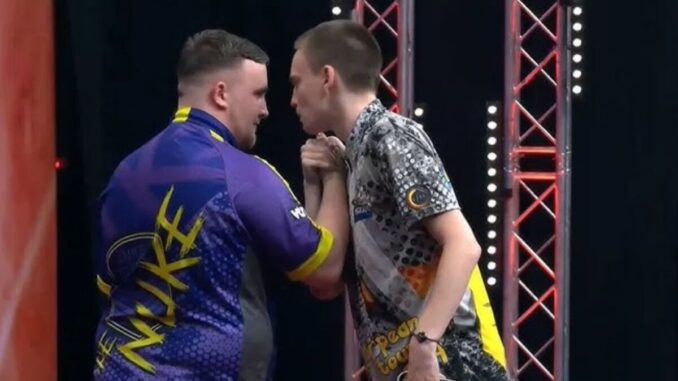
The roar of the crowd, a cacophony of anticipation and fervent support, hung heavy in the air. The stage, bathed in the harsh glare of the spotlights, became the epicenter of a drama that transcended the simple act of throwing darts. It was a moment that crackled with tension, a palpable energy that threatened to spill over into something more. At the heart of it all stood Luke Littler, the teenage sensation who had taken the darts world by storm, and his Belgian Darts Open rival, a figure whose name now carried the weight of a heated confrontation.
The match itself had been a rollercoaster, a series of tightly contested legs that swung back and forth like a pendulum. Littler, known for his composure and remarkable accuracy, seemed to be battling not just his opponent, but also the mounting pressure of expectations. The crowd, a sea of faces illuminated by the flickering lights, chanted his name, their voices a constant reminder of the weight he carried on his young shoulders.
Then came the flashpoint. A moment of intense eye contact, a sudden surge of adrenaline, and a confrontation that left the audience gasping. The rival, his face flushed with emotion, stepped towards Littler, their proximity a stark illustration of the simmering animosity. Words were exchanged, sharp and pointed, cutting through the din of the arena. The atmosphere, already charged, became electric.
“There was a bit of needle,” a source later recounted, capturing the essence of the exchange. “It was just one of those moments where the heat of the competition got to them.”
The incident, captured by countless cameras and broadcast to a global audience, quickly became the talk of the darts world. Social media platforms buzzed with speculation, with fans dissecting every frame of the confrontation, searching for clues and interpretations. The debate raged: was it a mere clash of personalities, a byproduct of the high-stakes environment, or something more?
The rival’s actions, seen by many as a challenge to Littler’s composure, sparked a wave of reactions. Some condemned his behavior, labeling it unsportsmanlike and disrespectful. Others, however, saw it as a moment of raw passion, a testament to the intensity of the competition.
“He’s a young lad, and he’s dealing with a lot of pressure,” one observer noted, referring to Littler. “But he’s shown he can handle himself. He’s got a fire in him, and he won’t back down.”
Littler, for his part, remained relatively composed in the immediate aftermath of the confrontation. His focus, it seemed, was on the game, on the task at hand. He continued to throw his darts with remarkable precision, his movements fluid and deliberate. Yet, the tension lingered, a silent undercurrent that permeated every throw, every score.
The match continued, but the incident had irrevocably altered the dynamic. The crowd, now even more invested, roared with every successful dart, their support for Littler reaching fever pitch. The rival, sensing the shift in momentum, fought back with renewed determination, determined to salvage his reputation and prove his mettle.
“It’s all part of the game,” a seasoned darts veteran commented. “You’re going to have moments of friction, moments of tension. It’s how you handle those moments that defines you as a player.”
The incident underscored the intense pressure faced by professional darts players, particularly those in the spotlight. Littler, despite his youth, had become a global sensation, his every move scrutinized and analyzed. The weight of expectations, the constant media attention, and the relentless competition all contributed to the pressure-cooker environment.
“It’s not easy,” another observer remarked. “These guys are under immense pressure. They’re playing for pride, for prize money, for their livelihoods. Sometimes, emotions boil over.”
The confrontation also highlighted the evolving nature of darts, a sport that had long been associated with camaraderie and sportsmanship. While the core values remained, the increasing stakes and the intense competition had inevitably led to a more combative atmosphere.
“The game has changed,” a former player acknowledged. “It’s more competitive, more cutthroat. But that’s not necessarily a bad thing. It adds to the excitement, the drama.”
The aftermath of the incident saw a flurry of discussions about sportsmanship, respect, and the boundaries of competitive behavior. Pundits and fans alike debated the merits of the rival’s actions, with some calling for stricter measures to curb such confrontations.
“There needs to be a line,” one commentator argued. “You can’t just go around intimidating your opponents. It’s not good for the sport.”
Others, however, defended the rival’s right to express his emotions, arguing that it was a natural part of the competitive process.
“He’s a passionate guy,” one fan asserted. “He’s just trying to win. There’s nothing wrong with that.”
Regardless of the differing opinions, the incident served as a stark reminder of the human element in sports. Even in a game of precision and skill, emotions can run high, and tempers can flare. The confrontation between Littler and his rival had added a dramatic chapter to the ongoing narrative of professional darts, a chapter that would undoubtedly be replayed and analyzed for years to come. Ultimately, the focus returned to the game, and the players, regardless of their personal feelings, were forced to continue the contest. The crowd, though still buzzing with the memory of the confrontation, cheered on their favorites, eager to witness the outcome of this high-stakes battle.
Leave a Reply